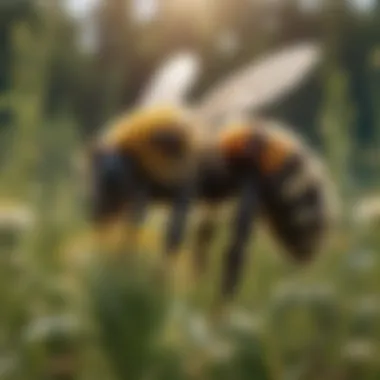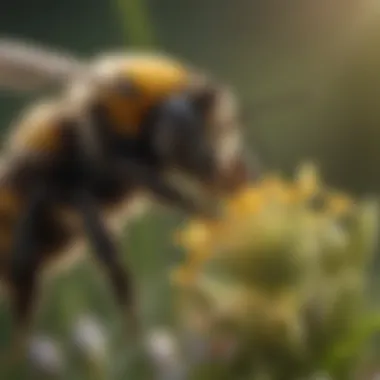Unveiling the Multifaceted World of Bumblebee Varieties


Bumblebees, with their striking colors and distinct buzz, encapsulate the richness of the natural world. This article ventures into the intricate realm of bumblebee types, shedding light on the diverse species, their unique characteristics, and the critical roles they play in sustaining ecosystems. From the common Western bumblebee to the elusive Rusty-patched bumblebee, the world of bumblebees beckons with wonders waiting to be discovered.
Diversity of Bumblebee Species
The world of bumblebees is a kaleidoscope of colors and patterns, with over 250 species adding vibrancy to landscapes across the globe. Each species boasts distinctive features, from their size and coloration to their foraging habits and social structures. Exploring this vast array of bumblebee species unveils a tapestry of biological diversity that enriches the floral tapestry of our planet.
Ecological Importance of Bumblebees
Beyond their aesthetic appeal, bumblebees serve as crucial pollinators in both natural and agricultural settings. Their fuzzy bodies are adept at picking up and transferring pollen, facilitating the reproduction of flowering plants. This pollination process is integral to ecosystem functioning, as well as the production of fruits and seeds that sustain various animal species, including humans.
Bumblebees in a Changing Environment
As our world grapples with environmental changes, bumblebee populations face multiple threats, including habitat loss, pesticide use, and climate change. Understanding how bumblebees adapt to and are affected by these shifts is vital for their conservation and the maintenance of biodiversity. By studying the responses of different bumblebee species to changing environmental conditions, researchers can acquire insights into strategies for effective conservation and management.
The Future of Bumblebee Conservation
Conservation efforts aimed at protecting bumblebee populations are gaining momentum worldwide. Initiatives ranging from creating pollinator-friendly habitats to advocating for sustainable agricultural practices play a crucial role in securing the future of these industrious pollinators. Through a concerted effort involving scientists, policymakers, and the general public, the plight of bumblebees can be addressed, ensuring their survival and the preservation of ecosystems they contribute to.
Introduction
Within the realm of bumblebee types lies a fascinating world that plays a crucial role in ecosystems worldwide. This article aims to delve into the diverse spectrum of bumblebee species, shedding light on their unique characteristics, behaviors, and ecological significance. By exploring the rich tapestry of bumblebee diversity, we can gain a deeper understanding of their importance in sustaining plant life and biodiversity.
Understanding Bumblebees
Overview of Bumblebees
Delving into the intricacies of bumblebee species reveals a multitude of unique characteristics that set them apart from other pollinators. Their fuzzy bodies, vibrant colors, and distinctive buzzing flight patterns make them easily recognizable. The efficient pollination service they provide is crucial for the reproduction of many flowering plants. This section will dissect the various aspects of bumblebee anatomy and behavior, providing insights into why they are an integral part of our ecosystem.
Importance in Pollination
The role of bumblebees in pollination cannot be overstated. Their specialized feeding behaviors and ability to 'buzz' pollinate certain flowers make them indispensable pollinators for a wide range of plant species. By transferring pollen from one flower to another, bumblebees facilitate plant reproduction, ultimately contributing to ecosystem stability and genetic diversity. This section will highlight the intricate relationship between bumblebees and flowering plants, emphasizing the importance of their pollination services in maintaining healthy ecosystems.


Significance of Bumblebee Diversity
Ecological Impact
The diverse array of bumblebee species across different regions exerts a significant ecological impact on local plant communities. By foraging on a wide variety of flowering plants, bumblebees aid in the pollination of both wild and cultivated species. Their role as key pollinators enhances the reproductive success of numerous plant populations, influencing overall ecosystem dynamics. This section will delve into the ecological importance of bumblebee diversity and its implications for plant biodiversity and community structure.
Adaptations to Environments
Bumblebees have evolved a remarkable set of adaptations to thrive in various environments, ranging from temperate forests to alpine meadows. Their ability to regulate body temperature, forage efficiently, and navigate complex landscapes showcases their remarkable adaptability. Understanding these adaptations sheds light on how bumblebee species have diversified and survived in different habitats over time. This section will explore the evolutionary strategies that have enabled bumblebees to inhabit diverse ecosystems, highlighting the remarkable resilience and versatility of these pollinators.
Common Bumblebee Types
In this article, the focus on Common Bumblebee Types is pivotal as it forms the foundational understanding of bumblebees. Common bumblebee types serve as the basis for comparison with rarer varieties, allowing for a comprehensive exploration of the entire spectrum of bumblebee diversity. Understanding the characteristics, behaviors, and ecological roles of common bumblebees is essential in grasping the broader significance of these pollinators. By delving into the specific elements of common bumblebee types, readers can gain insights into their importance and how they contribute to the ecosystem.
North American Bumblebee
Physical Characteristics:
The physical characteristics of North American bumblebees play a crucial role in their survival and adaptability. With distinct features such as robust bodies, hairy textures, and vibrant colors, North American bumblebees boast unique traits that aid in pollination and identifying different species within their habitats. The adaptation of these physical characteristics to varying environments showcases their resilience and effectiveness as pollinators in North America. Understanding the unique attributes of their physical characteristics sheds light on the evolutionary strategies employed by these bumblebees.
Behavioral Patterns:
The behavioral patterns exhibited by North American bumblebees are equally significant in their ecological interactions. From foraging techniques to mating rituals, North American bumblebees demonstrate complex behaviors that contribute to their roles as pollinators and key components of ecosystems. Studying these behavioral patterns provides valuable insights into their foraging efficiency, social structures, and responses to environmental changes. By examining the behavioral patterns of North American bumblebees, researchers and enthusiasts can unravel the intricate dynamics of these fascinating insects.
European Bumblebee Species
Diversity Overview:
The diversity of European bumblebee species offers a rich tapestry of ecological variations and adaptations. With a wide range of sizes, color patterns, and habitat preferences, European bumblebees showcase an unparalleled spectrum of diversity that reflects the continent's diverse landscapes. Exploring the taxonomy and distribution of these species provides a comprehensive overview of their adaptability and genetic diversity. By understanding the diversity of European bumblebee species, researchers can comprehend the evolutionary processes that have shaped their populations over time.
Role in Ecosystems:
The role played by European bumblebee species in ecosystems is multifaceted and indispensable. As key pollinators of various plant species, European bumblebees contribute significantly to ecosystem health and biodiversity. Their foraging behaviors, pollen transportation mechanisms, and nest-building activities represent critical links in the intricate web of ecological interactions. Analyzing the role of European bumblebee species in ecosystems sheds light on the intricate relationships between these insects and their surrounding flora and fauna. By recognizing their ecological significance, conservation efforts can be tailored to protect and preserve European bumblebee populations for future generations.


Rare Bumblebee Finds
In this section of the article, we delve into the captivating realm of Rare Bumblebee Finds, a topic of utmost importance in our exploration of the diversity of bumblebee types. Rare bumblebee species play a crucial role in maintaining biodiversity and ecosystem resilience. These unique finds offer researchers and conservationists valuable insights into evolutionary adaptations and environmental challenges that ordinary species may not face.
Endangered Bumblebee Species
Conservation Efforts
When it comes to discussing Conservation Efforts for Endangered Bumblebee Species, it is essential to highlight the meticulous planning and implementation strategies aimed at safeguarding these vulnerable populations. Conservation efforts involve a multi-faceted approach, including habitat restoration, captive breeding programs, and community engagement initiatives. The key characteristic of these efforts lies in their collaborative nature, where scientists, policymakers, and local communities come together to protect and restore bumblebee habitats.
Habitat Protection
Habitat Protection stands as a fundamental pillar in the conservation of Endangered Bumblebee Species. Preserving and enhancing natural habitats is critical for bumblebee populations to thrive and propagate. Conservationists prioritize habitat protection by identifying key areas of ecological significance, implementing sustainable land management practices, and advocating for policies that support biodiversity conservation. The unique feature of habitat protection lies in its long-term sustainability impact, ensuring the continued existence of endangered bumblebee species in their natural environments.
Exotic Bumblebee Varieties
Unique Characteristics
Exploring the Unique Characteristics of Exotic Bumblebee Varieties sheds light on the diverse adaptations and evolutionary traits that set these bees apart. From iridescent colorations to specialized foraging behaviors, exotic bumblebee varieties fascinate researchers and enthusiasts alike. The key characteristic of these unique traits is their role in enhancing the resilience and genetic diversity of bumblebee populations, offering potential insights into future conservation strategies.
Habitats of Origin
Understanding the Habitats of Origin of Exotic Bumblebee Varieties provides valuable context regarding the environments in which these bees have evolved. From tropical rainforests to alpine meadows, each habitat presents distinct challenges and opportunities for bumblebee survival. By delving into the unique features of these habitats, researchers can better grasp the interplay between environmental factors and bumblebee adaptations, informing conservation efforts targeted at protecting these exotic species.
Bumblebee Ecology
Bumblebee ecology is a pivotal aspect of this comprehensive article, shedding light on the intricate interactions and behaviors of these fascinating pollinators within their ecosystems. Understanding the ecological dynamics of bumblebees is crucial for grasping their vital role in maintaining biodiversity and supporting floral populations. By delving into bumblebee ecology, we unravel the complexities of their foraging habits, nesting preferences, and symbiotic relationships with other organisms.
Foraging Behavior of Bumblebees
Pollination Strategies


When exploring the pollination strategies of bumblebees, we uncover a sophisticated and efficient mechanism that plays a fundamental role in ecosystem health. Bumblebees, with their fuzzy bodies designed for pollen collection, exhibit a specialized form of pollination known as buzz pollination. This unique technique involves vibrating their bodies at a specific frequency to release pollen from flowers that would otherwise remain inaccessible. Buzz pollination enhances pollination efficiency, enabling bumblebees to access nectar while inadvertently transferring pollen grains between flowers, promoting genetic diversity and plant reproduction.
Navigation Skills
The navigation skills of bumblebees are a marvel of natural intelligence, guiding them through complex floral landscapes with precision and accuracy. Bumblebees utilize a combination of visual cues, memory mapping, and even the Earth's magnetic field to navigate back to their nests after foraging expeditions. Their ability to communicate floral locations to their hive mates through intricate dances further underscores their remarkable navigational abilities. Despite their small size, bumblebees showcase a sophisticated spatial awareness that enables them to optimize foraging efficiency and contribute significantly to pollination processes.
Interactions with Flora and Fauna
Plant Relationships
Bumblebees' relationships with plants are founded on mutualistic interactions that benefit both parties involved. Through their nectar-seeking behavior, bumblebees facilitate the transfer of pollen between flowers, promoting cross-pollination and supporting plant reproduction. This symbiotic relationship enhances genetic diversity within plant populations, contributing to ecosystem resilience and floral abundance. Furthermore, bumblebees' preference for specific flower shapes and colors influences plant evolution, shaping the floral landscape in intriguing ways.
Predator-prey Dynamics
In the intricate web of nature, bumblebees participate in predator-prey dynamics that highlight the balancing act of ecological relationships. While bumblebees serve as vital pollinators for many plant species, they also fall prey to various predators such as birds, insects, and spiders. These predation pressures have catalyzed the evolution of defensive strategies in bumblebees, including mimicking the appearance of stinging insects and creating underground nests for protection. Understanding these predator-prey dynamics provides insights into the complex interplay between bumblebees and the broader ecosystem, illustrating the fragility and resilience of natural communities.
Conservation Efforts and Future Prospects
Conservation efforts and future prospects play a pivotal role in safeguarding the delicate bumblebee populations and maintaining ecological balance. In the context of this in-depth exploration of bumblebee diversity, understanding and actively addressing conservation challenges are of paramount importance. By focusing on conservation efforts and future prospects, this article aims to shed light on the urgent need for concerted action to protect bumblebee species.
Challenges in Bumblebee Conservation
Habitat Loss
Habitat loss emerges as a significant threat to bumblebee conservation, with the destruction of natural habitats leading to the decline of crucial bumblebee populations. The key characteristic of habitat loss lies in its irreversible impact on bumblebee ecosystems, disrupting their natural foraging and nesting grounds. In this article, the emphasis on habitat loss underscores the pressing need for habitat restoration initiatives and the preservation of untouched areas vital for bumblebee survival. The unique feature of habitat loss resides in its far-reaching consequences, highlighting the necessity of implementing strategies to counteract habitat degradation and promote bumblebee habitat resilience.
Climate Change Impact
Climate change exerts a profound influence on bumblebee populations, affecting their distribution, behavior, and interactions within ecosystems. The critical nature of climate change impact stems from its exacerbation of existing threats to bumblebee survival, intensifying challenges related to habitat availability and resource abundance. This article underlines the significance of addressing climate change in bumblebee conservation efforts, emphasizing the need for adaptive measures to mitigate its adverse effects on bumblebee populations. The specific feature of climate change impact lies in its ability to reshape ecosystem dynamics rapidly, necessitating holistic approaches to safeguard bumblebee habitats and ensure their long-term viability.
Research and Initiatives
Scientific Studies
Scientific studies play a fundamental role in advancing bumblebee conservation practices, providing researchers with vital insights into bumblebee behavior, ecology, and population trends. The key characteristic of scientific studies lies in their ability to uncover hidden facets of bumblebee biology, guiding conservation strategies and policy decisions. Within this article, scientific studies are highlighted for their contribution to expanding our understanding of bumblebee dynamics and informing conservation efforts. The unique feature of scientific studies lies in their capacity to drive evidence-based conservation initiatives, enhancing the efficacy of bumblebee protection measures and promoting sustainable bumblebee management practices.
Community Involvement
Community involvement stands as a cornerstone of successful bumblebee conservation, fostering partnerships between local residents, conservation organizations, and researchers to safeguard bumblebee habitats. The key characteristic of community involvement lies in its ability to mobilize collective action and promote grassroots conservation initiatives that benefit bumblebee populations. Within the context of this article, community involvement is underscored for its role in raising awareness, engaging stakeholders, and implementing on-the-ground conservation projects. The unique feature of community involvement resides in its capacity to foster a sense of environmental stewardship and empower communities to take an active role in bumblebee conservation efforts, leading to sustainable outcomes for bumblebee populations and their habitats.



